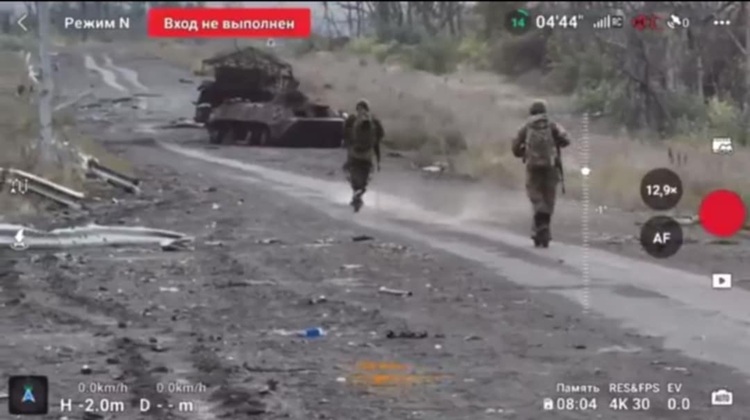
After a spring of substantial stalemate, the Pokrovsk sector (Donetsk Oblast) has seen a sharp intensification of offensive operations by the Russian Army's Central Group during summer.
Starting on July 23, Moscow's forces, attacking from the villages of Boikivka and Novotoretske—located about 15 km northeast of Pokrovsk—managed to break through Ukrainian defenses in the Kazenyi Torets River area. At first, the Russians expanded their bridgehead on the western bank of the river, launching an attack westward along the tree lines south of Nykanorivka. They then captured the village of Mayak, 5 km south of Nykanorivka, managing to enter Pankivka, while 5 km further west, they took control of Nove Shakhove.
Meanwhile, east of Kazenyi Torets, Russian troops advanced rapidly towards Volodymyrivka, while to the southwest – in the direction of Rodynske – they completed the capture of Fedorivka, reaching the eastern outskirts of Zatyshok. To the southwest, after fierce fighting that saw the village change hands several times, the Russians finally captured Razine, advancing to the gates of Chervonyi Lyman, located 5 km further west.
To the north, Russian forces took control of positions within the salient formed between Fedorivka and Nykanorivka. About 10 km further east, Moscow's troops advanced on a broad front from Volodymyrivka to Poltavka, securing numerous positions on the tactical heights along the Kazenyi Torets River. Assault units also gained full control of the Dobropolsky and Biryuch gypsum quarries, pushing into the forest north of Poltavka and establishing themselves in the first houses of the village. The Russian troops then continued their advance from the Fedorivka–Boikivka area, capturing numerous positions in the wooded areas on the heights to the west, completing the capture of Zatyshok, and immediately pushing southwest and capturing the village of Sukhetske. Russian reconnaissance and sabotage groups then penetrated the northern part of Rodynske, a village located about 4 km south of Zatyshok, operating in residential neighborhoods. To the north, Russian forces completed the capture of Nykanorivka, while reconnaissance and sabotage groups penetrated Bilytske.
Between July 25 and 30, it was the front south of Pokrovsk that saw significant progress, particularly towards the nearby town of Myrnohrad (east of Pokrovsk). Starting from positions in the village of Mykolaivka, located 3 km further south, the Rusian troops reached the wooded areas immediately south of the town, while reconnaissance and sabotage groups pushed as far as inside the southern part of the town. About 4 km west, starting from Zelene, Russian forces resumed assault operations from the Shevchenko area, breaking through Ukrainian defenses along the railway line. The village of Novoukrainka fell quickly, while Chunyshyne is still contested. The intense activity of Russian units north of Pokrovsk—which inflicted heavy damage on Ukrainian logistics—facilitated the capture of Zvirove, its terykon (mining heap), and Leontovychi. Moscow's troops then penetrated Pokrovsk itself, creating a bridgehead in the Kalynivka district. Assault units and reconnaissance and sabotage groups then began to operate actively in the Shakhtarskyi district, although no definite line of contact is known, as the situation on the ground in this area is extremely fluid.
At the same time, Russian forces resumed assault operations towards the T-0406 road, located 3 km northwest of Zvirove, occupying a section of it. Between July and August, there was a significant increase in the use of UMPK glide bombs by the Russian Air Force throughout the Pokrovsk sector. As in the past, the concentration of artillery and glide bombs (UMPK) paved the way for Russian troops who, using electric scooters and motocross bikes (in picture), divided into small, fast assault groups, managed to penetrate the Ukrainian front. In particular, on August 10, northeast of Pokrovsk, 13 km east of Dobropillya, Russian forces achieved a significant success, penetrating Ukrainian lines 7 km deep. After intense artillery activity on the village of Zolotyi Kolodyaz, Russian units infiltrated the poorly defended Ukrainian lines east of Nove Shakhove, advancing about 10 km north and entering the village of Zolotyi Kolodyaz, but failing to capture it.
Subsequently, the assault troops, following the path of the scouts, advanced northwards towards Zolotyi Kolodyaz along the tree lines on the tactical heights and captured positions in the Velyka Balka gorge. Meanwhile, further south, the Russians brought in reinforcements to support the assault operations. These reinforcements attacked along the flanks in order to widen the salient, entering the village of Nove Shakhove and approaching the eastern outskirts of Vilne.
To the east, Russian forces continued to advance towards Shakhove, completing the capture of Pankivka and aligning the front on the opposite bank of the Kazenyi Torets River, in Volodymyrivka. Southwest of the breakthrough, Russian forces continued their assaults on Ukrainian strongholds at the Dorozhnje freight railway station and in the adjacent village of the same name. Meanwhile, reconnaissance and sabotage groups continued to infiltrate south of Bilytske, reaching the Dobropillya–Pokrovsk highway. In the following days, after consolidating their advance between Dobropillya and Shakhove, Russian forces continued to follow the reconnaissance and sabotage groups, which by then were operating up to 10 km ahead of the assault troops.
This situation, combined with poor coordination, disorganization, and a lack of personnel in the field, made the Ukrainian troops completely incapable of conducting any containment operations, despite the deployment of reserves in the area. The Russian advance then developed along two vectors.
The first, and most significant, was west of the Velyka Balka gorge; here Russian troops advanced to Zolotyi Kolodyaz and entrenched themselves in the southern part of the village. Other units veered west, crossing the Hruzka River and then advancing northwest, managing to physically cut the Dobropillya–Kramatorsk highway in two places.
The second attack vector developed east of the Velyka Balka gorge, where Russian forces captured three quarries, bypassing the village of Kucheriv Yar from the east and advancing north along the tree lines on the heights towards the villages of Vesele and Hruzke, both located on the banks of the Hruzka River. Reaching the southern bank of the river, the Russians crossed it, taking control of about half of Vesele. Other units descended from the heights and entered Kucheriv Yar, occupying it without encountering resistance. As for the reconnaissance and sabotage groups, they began to move westward, successfully infiltrating about 10 km through the fields around Rubizhne, Stepy, Novyi Donbas, Vilne, Novovodyane, Vesele Pole, and Nove Shakhove, managing to enter the town of Dobropillya and the village of Bilozerske. Meanwhile, further south, Russian forces continued to clear positions northeast of Bilytske, establishing control of the forest west of Nykanorivka and advancing along the tree line to the northern section of Dorozhnje. In the following days, Russian reconnaissance and sabotage units managed to advance to the outskirts of the villages of Hryshyne and Novooleksandrivka, located just 5 km north of Pokrovsk, rendering the penultimate remaining road out of Pokrovsk–Myrnohrad, the E-50 highway, unusable.
Dorozhnje and its railway station were occupied after more than a week of fighting, as were Ivanivka and Nove Shakhove further north. Russian reconnaissance and sabotage groups pushed into and around Novyi Donbas, on the approaches to Dobropillya (located just 5 km further west). Starting on August 13, the Russians consolidated their control of Zolotyi Kolodyaz, also capturing the Krasnolymanskaya mine and its terykon.
Further south, assault troops pushed into the eastern part of Rodynske and made further advances in Chervonyi Lyman. Novoekonomichne, located 5 km east of Myrnohrad, came under Russian control, and advances were recorded northwest of Hrodivka and west of Myrolyubivka. In the north, Russian forces completed their capture of Dorozhnje and its freight railway station, also taking the village of Ivanivka and completing their occupation of Nove Shakhove. Meanwhile, Russian forces also advanced into Udachne, capturing its southern part and the railway station. The village, located about 10 km west of Pokrovsk, has been the scene of intense fighting for months due to the presence of the strategic T-0406 highway that runs through it and the coking coal mine of the same name.
After several days of fighting, starting on August 14, the Ukrainian High Command called in a large number of elite units from other areas of the front, including the 93rd Mechanized Brigade, the 12th AZOV Brigade of the National Guard, the 4th RUBIZH Brigade of the National Guard, the 1st DA VINCI Assault Battalion, the 25th Assault Battalion, the KORD Special Police Battalion, and a battalion belonging to the 82nd Air Assault Brigade. Russian forces were largely repelled from the approaches to Dobropillya and Bilozerske, while Ukrainian forces immediately launched a counterattack. On August 16, Ukrainian forces recaptured the village of Vesele. The following day, after securing the section of the Dobropillya–Kramatorsk highway previously occupied by Russian forces, the 1st DA VINCI Assault Battalion counterattacked in the direction of the village of Zolotyi Kolodyaz, managing to capture it and taking about 20 prisoners. The troops of the 12th AZOV Brigade, after eliminating the Russian vanguards that had penetrated in the direction of Dobropillya, quickly recaptured the villages of Vilne, Ivanivka, Novyi Donbas, Rubizhne, and Dorozhnje. Meanwhile, the 2nd Mechanized Battalion of the 93rd Brigade counterattacked in the direction of Kucheriv Yar, but was repelled.
In Kucheriv Yar, despite fierce Ukrainian counterattacks, Russian forces managed to reorganize and launch a counterattack. West of the village, they climbed the Velyka Balka gorge, recapturing several entrenched positions and advancing 5 km to the heights northeast of Stepy, from where they pushed into the village of Rubizhne, which is still contested today. Four km further east, Russian soldiers recaptured numerous fortified positions along the gorge leading to Hruzke. In the Pokrovsk sector, Ukrainian forces regained control of most of the urban areas affected by Russian infiltration.
After Moscow's forces failed to break through beyond Zolotyi Kolodyaz and following successful counterattacks, the Ukrainians eliminated the last Russian reconnaissance and sabotage units, consolidating their positions in the Shakhtarskyi district, in the city center, and in the wooded area south of the E-50 highway. In addition, in the southern sectors of the city, the Ukrainians have returned to Leontovychi, while Moscow maintains control of about half of the southern district of Kalynivka. On the northeastern flank of Pokrovsk, starting on August 24, Moscow's forces managed to take control of the large terykon overlooking Myrnohrad, then advancing west and southwest to the tree lines located about 1 km north of the city. At the same time, Russian troops managed to consolidate their positions near Chervonyi Lyman and in the wooded areas around Rodynske. In this context, exploiting a Russian breach in the Mykolaivka sector (7 km southeast of Chervonyi Lyman), which occurred due to poor coordination in the rotation of units at the front, Ukrainian forces managed to cross the Kazenyi Torets River and infiltrate the village of Myrne, temporarily disrupting the Pokrovsk–Kostyantynivka highway. Realizing the potential danger, the Russian command immediately sent in reinforcements, which managed to recapture Myrne and eliminate the Ukrainian reconnaissance and sabotage groups that had begun operating in the sector.
In recent days, the Russians have continued their offensive towards the fortified village of Shakhove (24 km northeast of Pokrovsk), widening the breach in Ukrainian defenses. The advance has developed along three main axes: to the west, where in recent days assault troops have gained ground until reaching the western bank of the Kazenyi Torets River; in the Kucheriv Yar and Pankivka sectors, with the occupation of new positions near Shakhove and Toretske; to the southeast, where the assault east of Volodymyrivka allowed them to bypass the village. Finally, to the north, where the advance continued gradually towards Sofiivka, allowing Russian troops to capture new positions within the wooded areas located 2 km southeast of the village. On the western flank of Pokrovsk, it is worth noting the fall of Udachne into Russian hands after about 250 days of fighting. Meanwhile, the coal mine near the village remains under Ukrainian control.
In general, after the arrival of Ukrainian reinforcements and subsequent counterattacks, the situation on the ground is more stable for Kiev. Ukrainian forces have managed (for the time being) to stem the Russian breakthrough towards Dobropillya, reducing the Russian salient northeast of Pokrovsk, and to contain the infiltration of Russian reconnaissance and sabotage groups in the southern areas of the city. However, this has come at the cost of a clear weakening of other sectors of the front, such as Kupiansk, Siversk, and Kostyantynivka, where the Russians are advancing. Russian forces in the salient northeast of Pokrovsk, although they have lost ground, are continuing offensive operations to widen the breach in the Ukrainian perimeter, particularly in the direction of Shakhove. It remains to be seen whether the Ukrainians will succeed in suppressing the salient by attacking the Nove Shakhove-Shakhove bottleneck or, conversely, whether the Russians will succeed in widening the breach by capturing Shakhove. Beyond the battle for the salient, what can be deduced is that a key section of the Ukrainian defensive line, between Pokrovsk and Kramatorsk, is now definitively compromised.








.png)
